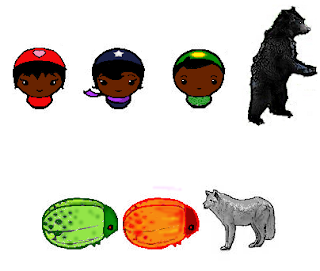a) tactical combat centered on magic and co-operation between mages;
b) strategic planning and interacting with a dynamic world.
Magic
In particular, all the PCs in the party will be mages. This means that there's no need to balance mages with warriors or other classes, and end up handicapping the mages; the game can unapologetically be designed so that mages are awesome from the start. There will also be a wide range of possible types of mage, and hence a large number of possible combinations; indeed, experimenting with different ways to build a team, play off strengths and compensate for weaknesses will be an important part of the game (and should be fun :).
Here are the types of mage I'm currently planning to include:
- Shapeshifter: can shift into Bear, Wolf or Phoenix forms for combat, but only for a short time; Cat, Mouse or possibly Hawk for stalking, hiding and searching; Tree or Rock for regeneration and defence.
- Lifegiver: can provide physical and magical healing.
- Proxima: skilled at martial arts and short-range elemental attacks (such as ice touch).
- Scout: stealthy, quick, can turn invisible - possibly can teleport short distances.
- Augmenter: Enhances magical power, improves (or degrades!) bodies and minds.
- Enchanter: Improves equipment for limited periods or more permanently.
- Elementalist: Long-range, area elemental attacks and shields.
- Heartguard: Specialises in shields, counterspells and dispelling.
- Seer: Counter to a Scout; provides intelligence on the enemy's location and movement.
Typically a party would consist of 6 mages, and possibly some (mundane, non-magical) mercenaries.
Sample PC and monster icons

Here the icons represent, clockwise from the top left, a Lifegiver (healer); an Elementalist; an Augmenter; the Bear form of a Shapeshifter; the Wolf form of a Shapeshifter; a Firebug; and a Giant Undead LadyBird (GULB).
Image credits: The Bear is taken from a photo by Alan Vernon, available at http://www.flickr.com/photos/alanvernon/3200782322/; the Wolf is taken from a photo by Drew Avery, available at http://www.flickr.com/photos/33590535@N06/3520737474/. Both are licensed under the CC Attribution 2.0 Generic license http://creativecommons.org/licenses/by/2.0/deed.en. All other images are originally from Danc's PlanetCute set at http://www.lostgarden.com/2007/05/dancs-miraculously-flexible-game.html, under the CC Attribution 3.0 License (see http://www.lostgarden.com/2007/03/lost-garden-license.html).
Multiplayer Battles
It will be possible to play out a one-off battle, selecting a group of mages and their opponents and fighting on a chosen battlefield, either playing against a human opponent or an AI; if you've played multiplayer Battle of Wesnoth, you know what I mean. These battles will provide input on balancing the mage types (and indeed calculating relative strengths of mages versus various monsters).
Dynamic World, Non-linear Storyline
As mentioned, the world will be dynamic; enemies will be modeled independently and will indeed capture villages and towns unless they are stopped. They may also capture and hold to ransom friends or family of the party. Events will happen whether the PCs get there in time or not; so resting enough to fully heal the party and replenish their spells will be a strategic choice, not a free lunch. All this implies a highly nonlinear storyline.
Another planned feature is splitting the party. The player should be able to hire mercenaries and send them off on quests, with as many mages as desired. This would again be a matter of judgement; any understrength party would have a greater chance of failing at a quest.
Setting
The world would probably include standard fantasy features such as elves, dwarves, goblins, trolls and undead, with a few twists. Dragons will be very rare and powerful. There may also be Titans and their allies, very powerful and magical survivors of an ancient war with the elves.
Influences
Influences of this game include Pool of Radiance (my favourite of the SSI D&D games I played), Wizardry games, in particular Bane of the Cosmic Forge and Crusaders of the Dark Savant, Final Fantasy X, Kingdom Hearts, and Battle of Wesnoth (as previously mentioned).
For More Details
If you're interested in helping design this game, or just in knowing when releases come out, contact me by leaving a comment on this blog or send me a message via my Twitter account. I'll post details of a forum and/or mailing list on this blog when I set them up.
Closing Thoughts
This all sounds ambitious, and it will be a slow process developing this game, but the end result will be awesome.